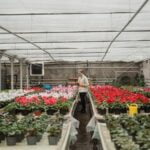Are you struggling to find ideas for very small front gardens? Limited space doesn’t have to mean limited creativity when it comes to designing a beautiful and functional front garden.
In this article, we will explore various strategies for maximizing the potential of small front gardens, from utilizing vertical space to choosing the right plants and incorporating functional elements. With the right approach, even the smallest front yard can become a stunning outdoor space that adds curb appeal and joy to your home.
Small front gardens present unique challenges but also offer plenty of potential for creative design solutions. With a focus on maximizing every inch of space, you’ll discover how to make the most of your limited outdoor area. From vertical gardening techniques to clever illusions of space, there are countless possibilities for transforming small front gardens into inviting and visually appealing landscapes.
In addition to discussing design ideas, we will also delve into practical tips for maintaining healthy and beautiful front gardens throughout the year. By embracing container gardening and nurturing biodiversity, even the tiniest front garden can thrive with lush greenery and vibrant blooms. Join us as we uncover the vast potential hidden within very small front gardens.
Maximizing Vertical Space
When dealing with a very small front garden, it’s important to make the most of every available space. One effective way to maximize space in a small front garden is by utilizing vertical space. By using walls, trellises, and hanging planters, you can create an eye-catching and functional design that makes the most of limited space.
One way to utilize vertical space in a small front garden is by creating a living wall. This can be achieved by installing modular planters directly onto a wall or fence, creating a lush and green focal point. Another option is to install trellises for climbing plants such as ivy, jasmine, or roses. Not only do these plants add visual interest, but they also help to create a sense of privacy and seclusion in a small outdoor area.
Hanging planters are another great option for adding greenery without taking up precious ground space. Consider installing hooks or brackets on walls or the underside of an awning to hang baskets filled with colorful flowers or trailing vines. Not only does this add visual interest at eye level, but it also leaves valuable floor space free for other design elements or functional features like seating.
Incorporating vertical gardening techniques into your small front garden not only adds visual interest but also increases the overall greenery within the limited space available. By choosing the right plants for vertical gardening and being mindful of maintenance requirements, you can ensure that your very small front garden remains visually appealing throughout the year.
Choosing the Right Plants
When it comes to very small front gardens, choosing the right plants is crucial to make the most of limited space and ensure low maintenance. With careful selection, even the tiniest garden can be a beautiful and thriving green space. Here are some ideas for selecting plants that are perfect for very small front gardens.
One great option for small front gardens is to use dwarf or compact varieties of plants. These smaller versions of traditional garden favorites take up less space while still providing all the beauty and benefits of their larger counterparts. For example, consider planting dwarf shrubs, compact perennial flowers, or miniaturized fruit trees to add visual interest without overwhelming your limited garden space.
Another idea for very small front gardens is to incorporate vertical gardening techniques. This can involve using climbing plants such as ivy or jasmine on trellises, training vines on walls, or using hanging planters to add greenery without taking up valuable ground space. Vertical gardening not only maximizes space but also adds depth and visual appeal to a small front garden.
Additionally, opting for low-maintenance plants is essential in a very small front garden where there may be limited time for upkeep. Look for species that require minimal watering, pruning, and fertilizing to keep your garden looking its best with minimal effort. Drought-tolerant succulents, ornamental grasses, and native wildflowers are excellent choices for low-maintenance small gardens.
| Plant Option | Description |
|---|---|
| Dwarf Shrubs | Smaller versions of traditional shrubs that take up less space. |
| Succulents | Drought-tolerant plants that require minimal watering. |
| Vertical Gardening | Using trellises, walls, or hanging planters to maximize space. |
Creating Illusion of Space
Utilizing Optimal Layout and Pathways
Designing a small front garden can be challenging, but there are ways to create the illusion of space through strategic layout and pathways. By utilizing curved pathways instead of straight lines, you can create the impression of a larger area. This also allows for more planting space along the edges. Additionally, using lighter colored paving stones or gravel can help reflect light and make the space appear brighter and more open.
Utilizing Scale and Proportion
When working with a very small front garden, it’s important to pay attention to scale and proportion. Choosing smaller plants and furniture that are proportional to the size of the space will prevent the area from feeling overcrowded. By keeping everything in proportion, you can maintain a sense of balance and visual harmony.
Creating Depth With Focal Points
Incorporating focal points such as a small statue, fountain, or visually stunning plant can add depth to a small front garden. By drawing attention to these focal points, you can create the illusion of depth and distance within the limited space. Placing these elements strategically can also draw the eye away from the boundaries of the garden, making it feel larger than it actually is.
By employing these tips for designing and organizing a small front garden, you can maximize your outdoor space regardless of its size. Through careful planning and thoughtful design choices, even the smallest front gardens can become inviting and visually appealing outdoor retreats.
Incorporating Functional Elements
When dealing with a limited space, every element in a small front garden should serve a purpose. Adding seating, lighting, and water features not only enhances the aesthetic appeal of the space but also makes it more functional for homeowners and visitors. For seating, consider small bistro sets or bench seating that can provide a cozy spot to enjoy the garden.
Lighting can also be strategically placed to illuminate the beauty of the garden at night and create a welcoming ambiance. Water features such as fountains or small ponds can add a sense of tranquility and attract birds and beneficial insects.
Incorporating these functional elements may seem challenging in very small front gardens but with some creativity, it is entirely possible to make it work. Folding furniture or compact seating options can be used to maximize space without sacrificing comfort. Additionally, LED lights are energy-efficient and come in various designs that can be installed without taking up much space. As for water features, there are many compact options available that can easily fit into even the tiniest of front gardens.
Ultimately, adding functional elements to small front gardens is about creating a harmonious balance between beauty and practicality. By carefully selecting and placing seating, lighting, and water features, homeowners can transform their limited outdoor space into an inviting oasis for themselves and their guests.
| Functional Element | Purpose |
|---|---|
| Seating | Provides a comfortable spot to enjoy the garden |
| Lighting | Illuminates the garden at night and creates a welcoming ambiance |
| Water Features | Adds tranquility, attracts wildlife, and beneficial insects |
Embracing Container Gardening
Container gardening is a fantastic way to maximize limited ground space in very small front gardens. With the right selection of containers and plants, homeowners can create a beautiful and thriving garden even with minimal outdoor space. From flowers to herbs and vegetables, container gardening offers endless possibilities for adding greenery and color to small front yards.
Choosing the Right Containers
When it comes to container gardening in very small front gardens, selecting the right containers is crucial. Opt for lightweight and durable materials such as plastic or fiberglass, especially if the containers need to be moved around frequently. Additionally, consider using hanging planters and vertical wall planters to further maximize space. For a cohesive look, choose containers that complement the overall design and aesthetic of the front yard.
Selecting Suitable Plants
Incorporating the right plants is essential when embracing container gardening in very small front gardens. Opt for compact varieties of flowers, herbs, and vegetables that thrive in containers. This includes plants like petunias, succulents, cherry tomatoes, and dwarf citrus trees. Additionally, consider mixing different plant heights and types to create visual interest within the limited space.
Maintenance and Care
Regular maintenance is key to ensuring the success of container gardening in very small front gardens. This includes proper watering, fertilizing, pruning, and pest control as needed. Keep an eye on the condition of the containers as well, especially during extreme weather conditions. Overall, container gardening requires a bit of extra attention compared to traditional ground planting but can result in a stunning garden despite size limitations.
By embracing container gardening techniques in very small front gardens, homeowners can transform their outdoor spaces into lush and inviting areas that make a big impact despite their size limitations. With careful selection of containers and plants along with proper maintenance practices, even the smallest front yards can become vibrant displays of natural beauty.
Nurturing Biodiversity
Creating a biodiverse and wildlife-friendly small front garden is not as challenging as it may seem. Even with limited space, there are many ways to attract beneficial insects and wildlife to your outdoor space. By incorporating the right elements, you can provide a habitat for birds, bees, butterflies, and other creatures that can contribute to the health and beauty of your garden.
Consider these ideas for nurturing biodiversity in very small front gardens:
- Plant a variety of native plants: Native plants are essential for supporting local wildlife. They provide food and shelter for insects, birds, and small mammals. Research which native plants are suitable for your region and choose a diverse selection to attract different species.
- Install a bird feeder or bird bath: Even the smallest front garden can benefit from the presence of birds. Installing a bird feeder or bird bath can attract feathered visitors to your space. Make sure to keep them clean and filled with fresh water and food to encourage regular visits.
- Create a mini-pond: If space allows, consider adding a small pond or water feature to your front garden. Even a shallow container filled with water can attract frogs, dragonflies, and other aquatic creatures. Not only does it add visual interest to your garden, but it also provides essential water sources for wildlife.
By incorporating these elements into your very small front garden, you can create a thriving ecosystem that supports biodiversity and contributes to the overall health of your outdoor space. Whether you have limited ground space or minimal resources, there are always ways to make your garden environment more welcoming to beneficial insects and wildlife.
Maintenance Tips
In conclusion, while very small front gardens may present some challenges, there are numerous creative and practical solutions for maximizing their potential. By utilizing vertical space through the use of walls, trellises, and hanging planters, homeowners can make the most of limited ground space. Additionally, choosing the right plants that are low maintenance and space-saving can create a beautiful and thriving garden in a small area.
Designing and organizing a small front garden to create the illusion of space is also essential. This can be achieved through careful placement of elements, such as using paths to lead the eye, creating focal points, and avoiding clutter. Incorporating functional elements like seating areas, lighting, or water features not only adds visual interest but also enhances the usability of the space.
Furthermore, embracing container gardening allows for flexibility and mobility in arranging plants and can help make the most of limited ground space. Nurturing biodiversity by selecting plants that attract wildlife and beneficial insects is another key aspect of maintaining a healthy and vibrant small garden.
Lastly, by following proper maintenance tips throughout the year, homeowners can ensure that their very small front gardens remain healthy and beautiful for seasons to come. Overall, with careful planning and thoughtful execution utilizing these ideas for very small front gardens can result in stunning outdoor spaces that make a big impact.
Frequently Asked Questions
How Do You Make a Small Front Garden Nice?
Making a small front garden nice involves careful planning and utilization of space. You can incorporate colorful plants, flowers, and small trees to add visual interest. Adding a seating area or pathway can also enhance the overall aesthetics.
How Can I Make My Small Front Yard Look Nice?
To make your small front yard look nice, consider adding some landscaping features such as flower beds, potted plants, or hanging baskets. Creating a focal point like a small water feature or a sculpture can also elevate the look of your yard.
How Do You Make a Small Garden for Cheap?
Creating a small garden on a budget is possible with some smart choices. Utilize seeds instead of buying mature plants, repurpose old containers for planters, and consider taking cuttings from friends’ or neighbors’ plants to propagate your own. Additionally, look for budget-friendly gardening tools and materials at thrift stores or online marketplaces.

Welcome to my gardening blog! I am passionate about plants and enjoy sharing my knowledge and experiences with others. In this blog, I will write about everything related to gardening, from tips on how to get started to updates on my own garden projects.





